ZHOVANKA, Ukraine — A chilly spring fog is the morning welcome to Ukraine’s troops on the war-front wasteland of the Donbas.
In a maze of trenches cutting through the fields, soldiers of Ukraine’s 10th Mountain Infantry Brigade prepare for guard watch.
Distant heavy booms are heard at the right flank.
“120-millimeter shells incoming,” soldiers say.
This Ukrainian strongpoint, called The Basin, defends what is left of Zhovanka, a deserted small town near the Russian-occupied city of Horlivka, some 570 kilometers southeast of Kyiv.
The thunderous impact is mixed with bursts of machine-gun fire. Ukrainian units farther down the frontline open fire in response to the enemy using heavy mortars prohibited by the Minsk cease-fire agreement.
Soldiers wade through timber-boarded trenches, their boots ankle-deep in the clay dirt of the night’s heavy rain.
Here at the front line, the troops’ mission is to keep an eye on enemy lines across the field and hold a finger on the trigger — constantly.
It’s been this way for years. The war in its eighth year has killed 14,000 people, claiming a dozen military casualties a month.
But now, the tension is higher.
In April, Ukraine held its breath as more than 100,000 Russian troops massed near the eastern border, giving Moscow the possibility to launch a full-fledged invasion quickly.
When the Kremlin said on April 22 it would pull back its forces, many sighed with relief — prematurely. Russia has never actually retreated and can attack at any moment.
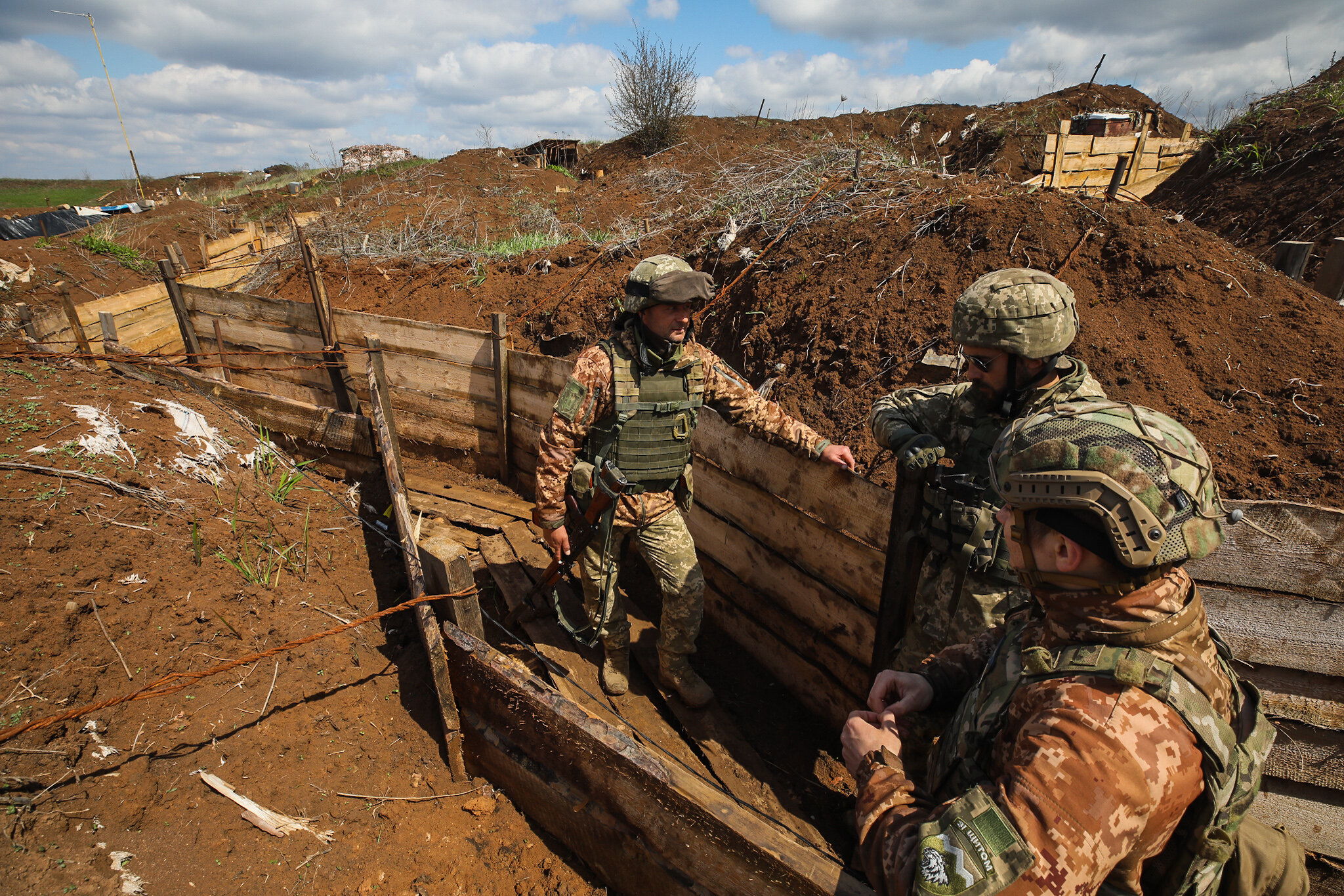
Ukrainian soldiers talk in front line trenches during a lull in the fighting near the Donbas war zone town of Zhovanka on April 28, 2021. (Volodymyr Petrov)
Deceptive silence
The Basin, a square of earthwork roughly 100 by 100 meters in size, warrants its name — at some spots, trench bottoms have turned into hard-to-pass brown swamps. The timber on the bottom is of no use.
“This can even be considered okay,” soldiers say, laughing, as they dive into narrow timbered corridors leading to machine-gun nests.
“In early springtime, when the snow melts, folks live here in the world of shit.”
The sound of distant fighting dies down, giving ease to the lone stronghold. But this silence is deceptive.
Over the last few months, this section north of Russian-occupied Horlivka, a key industrial center of 300,000 people, has become the most troublesome hotspot.
The deadliest area of this year of the war, the village of Shumy, lies just some six kilometers southwest of Zhovanka. There, scores of Ukrainian marines and army soldiers perished in combat.
Overall, 30 Ukrainian warfighters have been reported killed in Donbas in 2021, as the cease-fire established in July 2020 and advocated by Ukraine’s President Volodymyr Zelensky steadily degraded.

A Ukrainian soldier walks through the ruins of the Donbas war front town of Zhovanka on April 28, 2021. (Volodymyr Petrov)
Today, the front line generally remains in the same location as it was six years ago.
“That’s where the bastards are,” says a soldier manning an observation point on duty, looking east.
The crosshairs of his periscope binoculars are pointed at a damaged building next to a broken power wire pylon barely visible behind tall dry grass.
There, some 300 meters across the wild field, lies the first line of fortifications of Russia-backed militants occupying the southern half of the town of Zaitseve.
“On the other flank, they constantly deploy mortars and anti-tank guns at a school building,” soldiers lament.
“Come again, what does international law of war say about attacking civilian buildings?”
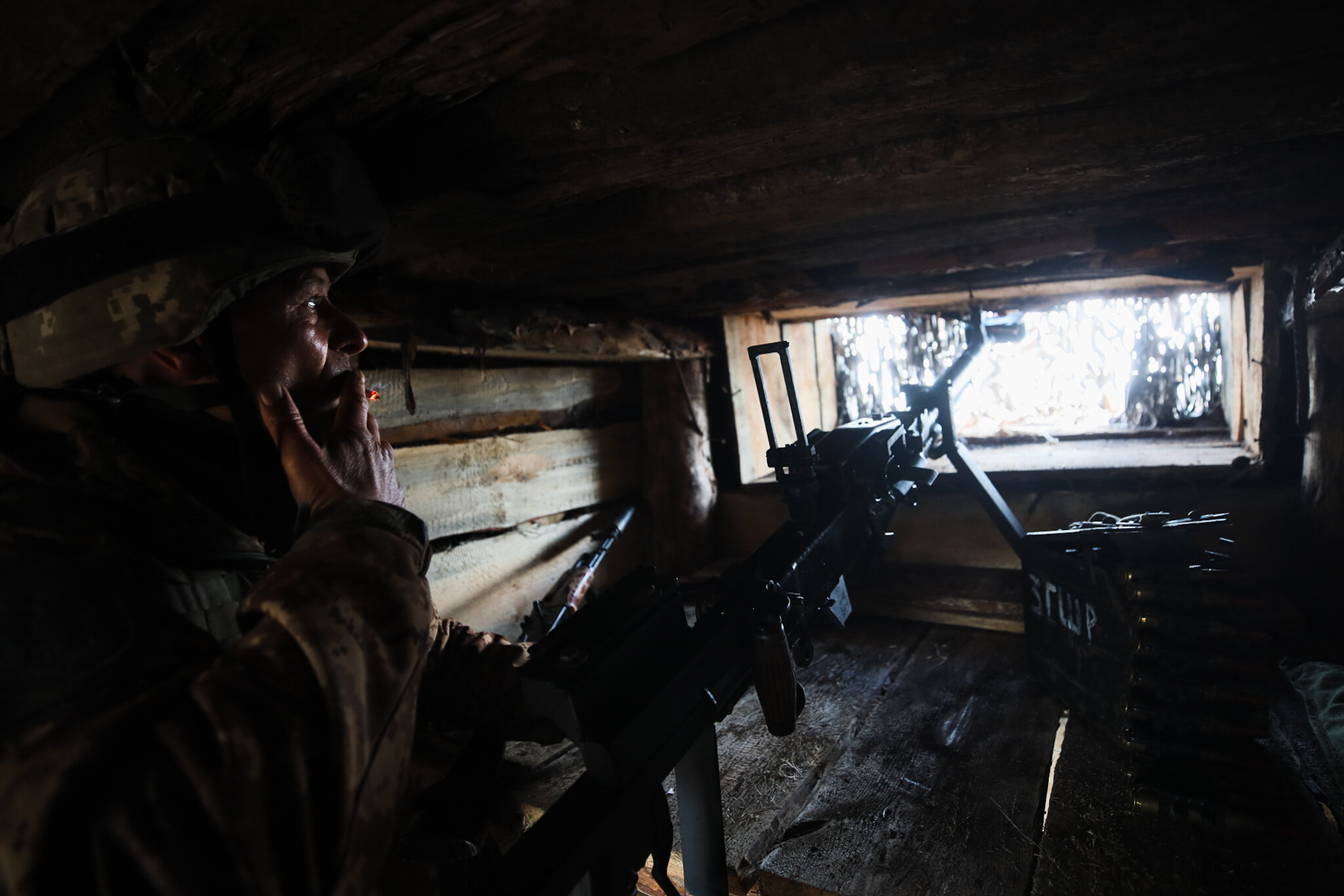
A Ukrainian soldier smokes a cigarette while he’s on watch duty in a front line machine gun nest near the Donbas war zone town of Zhovanka on April 28, 2021. (Volodymyr Petrov)
Different world
The mild spring sun soon dries the brown soil a little, and the world around starts looking less gloomy. High noon is the best time. Shortly after dusk and throughout the night, there is normally no action at all.
Relaxed off-duty soldiers get up from their bunk beds for a plastic cup of cheap coffee, a cigarette, and stew cooked in a dugout potbelly stove.
Some run around the trench lines in a bid to find a spot with a stable phone connection to say a few words to their loved ones at home.
“These are fresh, from a couple of nights before,” says a fighter, pointing at two impact holes left by 82-millimeter mortar shells and another huge crater left by a 120-millimeter. Both types of weapons are banned from use by the Minsk Agreements of 2015, but it rarely stops the militants.
A fatalistic, devil-may-care attitude is common. Soldiers off duty don’t wear helmets and armor.
In April, as Russia concentrated massive forces near Ukraine and openly threatened an invasion, doomsday tension filled the air.
Kyiv authorities notified the population of air raid shelters, media sounded the alarm, and Western capitals pondered their options in the case of a new Kremlin blitzkrieg.
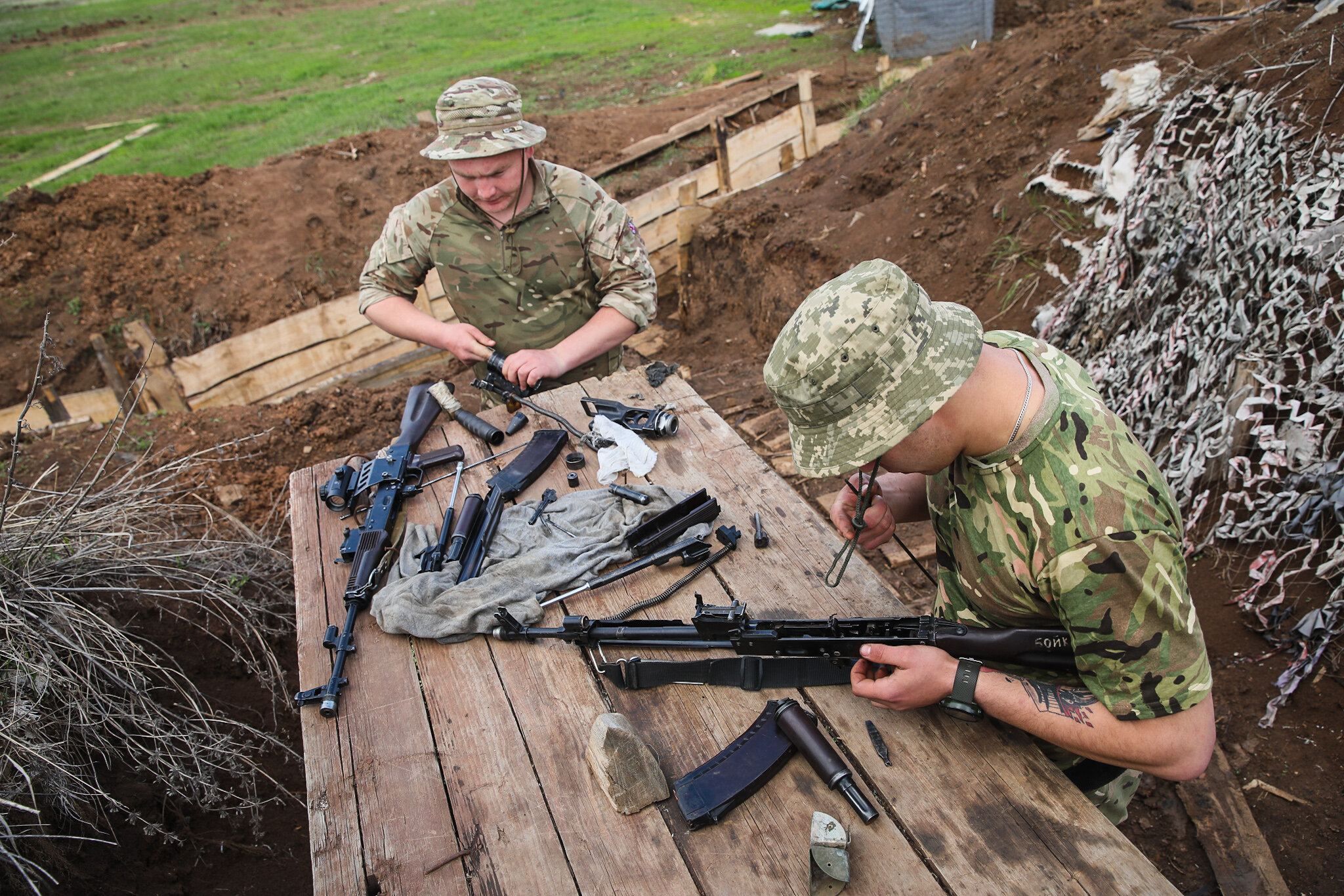
But for the soldiers at the front line, the worst national security crisis in years didn’t change their daily routine.
“It’s a nightmare what happens in this country right now, judging from the news,” soldiers often repeat the standing joke.
“It is scary to leave the war zone.”
But jokes aside, the standing army in the Donbas is confident that even should the Kremlin step in further, it will be given a good fight. And it will inevitably drown in a war it can’t win.
“This is not 2014 anymore,” the soldiers repeat here.
As soldiers dine and pet their trench line cats, the wind starts bringing a silent gentle buzz from high above. Is this someone’s radio set noise or what? But the sound becomes more distinct and closer with every second.
“Damn it, a quad-rotor again,” soldiers get up.
“Everybody take cover!”
What comes from the blue sky is the recent novelty of the Donbas war: The use of civilian drones — very cheap, small, and hard to notice, especially at night. Each might carry a bomb — normally a 40-millimeter VOG‑24–25 projectile, or a hand grenade, simply dropped upon a target.
In this very section of the front line, one of them killed 40-year-old soldier Oleksiy Mamchiy on April 15.
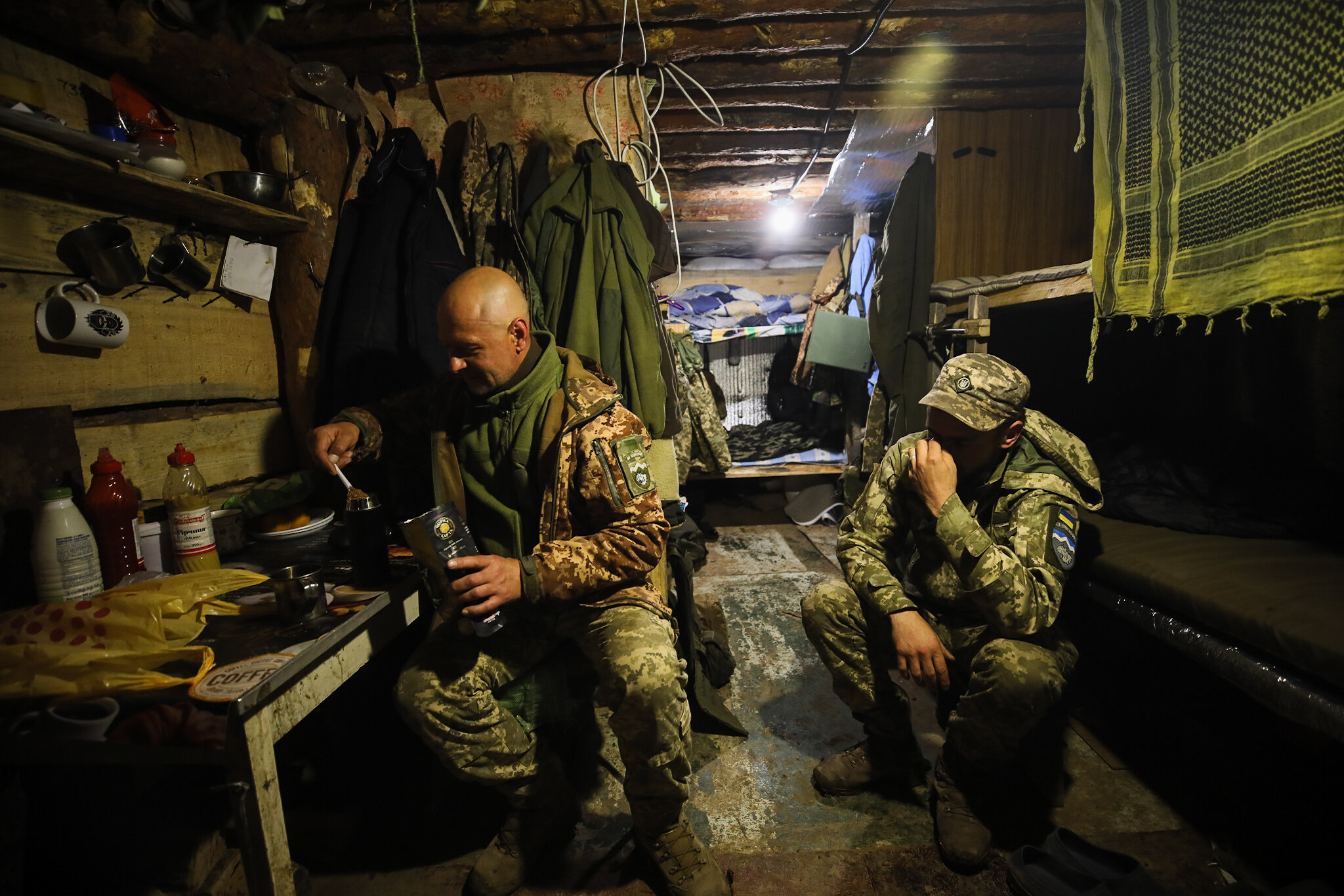
Ukrainian soldiers brew coffee in a front line dugout near the Donbas war zone town of Zhovanka on April 28, 2021. (Volodymyr Petrov)
Peace in two days
Before the war, Zhovanka used to be a merry, quiet suburb of Horlivka buried in the green of single-store households and gardens.
The seven years of war have rendered this land uninhabitable until full peace.
Today, Zhovanka is nothing but a post-apocalyptic ghost town almost completely swept off in never-ending artillery duels. The decaying silent streets absorbed by the wild nature now harbor only a handful of survivors, mostly elderly people having nowhere to go.
From a certain spot, one can see a Russian flag fluttering over the enemy lines — while the Kremlin keeps denying its forces’ presence in eastern Ukraine, militants are sometimes rather honest about who they are commanded by.
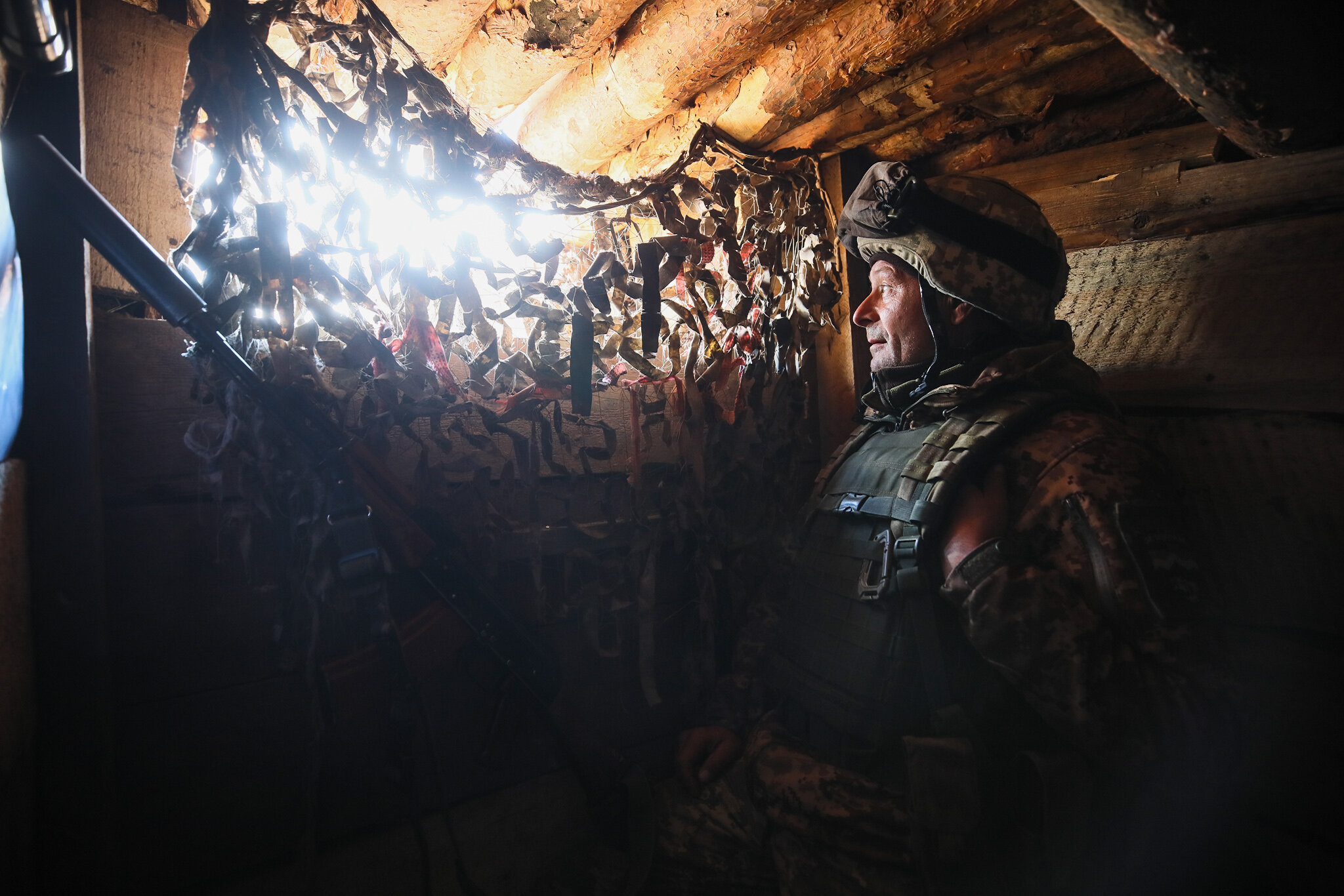
A Ukrainian soldier watches the enemy lines in a dugout near the Donbas war front town of Zhovanka on April 28, 2021. (Volodymyr Petrov)
“Yes, this is all about Russia, and nothing else,” says Dmytro Voronenko, a young officer who nevertheless is one of The Basin’s seniors.
“If Russia stops backing this mess, the war will be over in two days. I don’t even think we’re going to go over the top and break the front in this case. We’re having no illusions here — most of the local people standing against us over there get enlisted because they can’t get a decent job and feed their families.”
Ukrainian troops at the front line say they see the presence of who they believe are Russian regular military specialists, professional and highly-trained.
For instance, a Ukrainian surveillance camera in the Zhovanka area was knocked out a while ago — in a single sharp sniper shot from a distance of over 800 meters.
“I don’t believe militants would seriously want to fight and die for this bullshit if Russia leaves,” Voronenko continues.
“We would get back home too, with our mission accomplished. But here we go again — another day, another fight.”
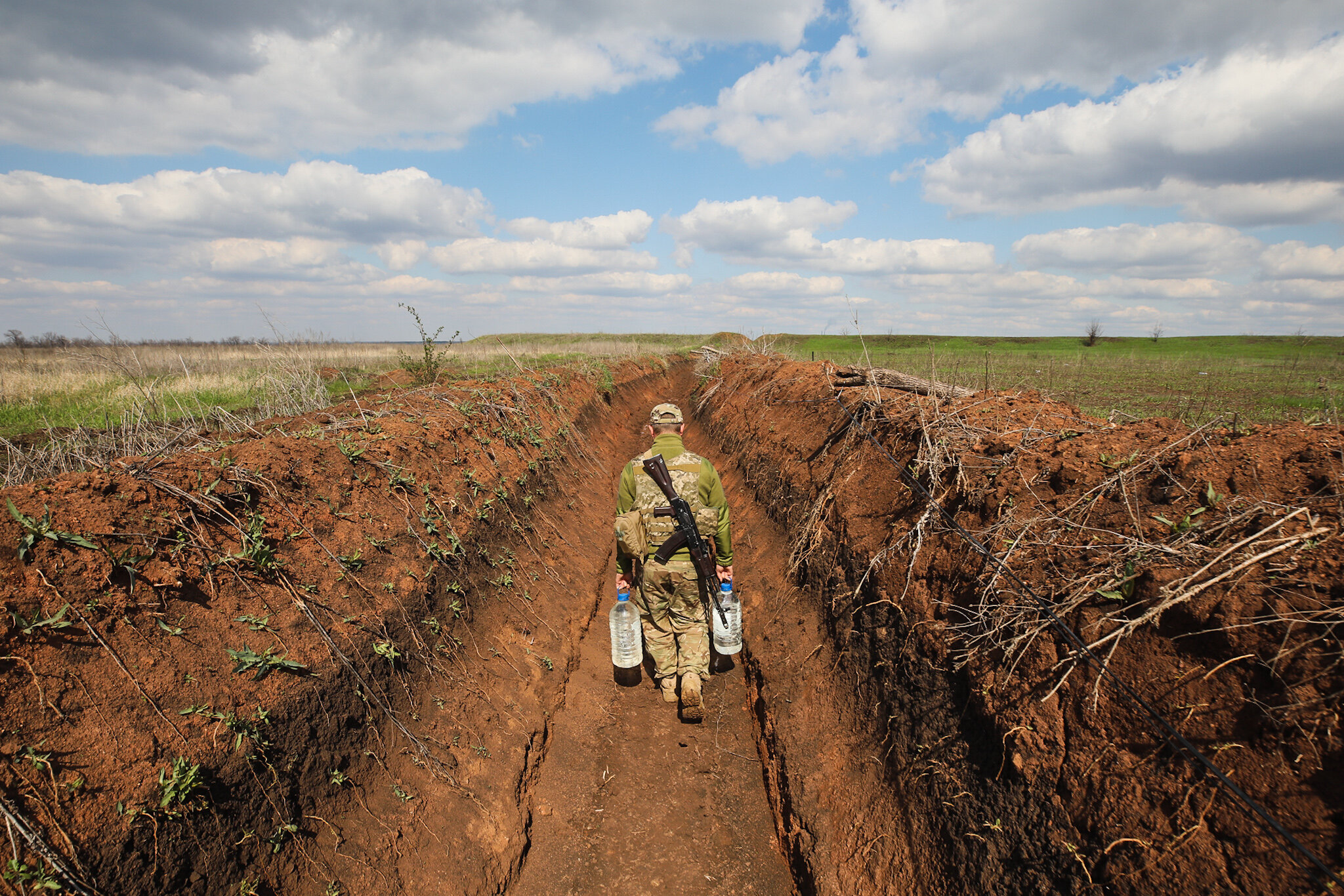
A Ukrainian soldier carries water bottles near the Donbas war front town of Zhovanka on April 28, 2021. (Volodymyr Petrov)
